Petrographic and Geochemical Inferences for Genesis of Terra Rossa: A Case Study from the Apulian Karst (Southern Italy)
Abstract
:1. Introduction
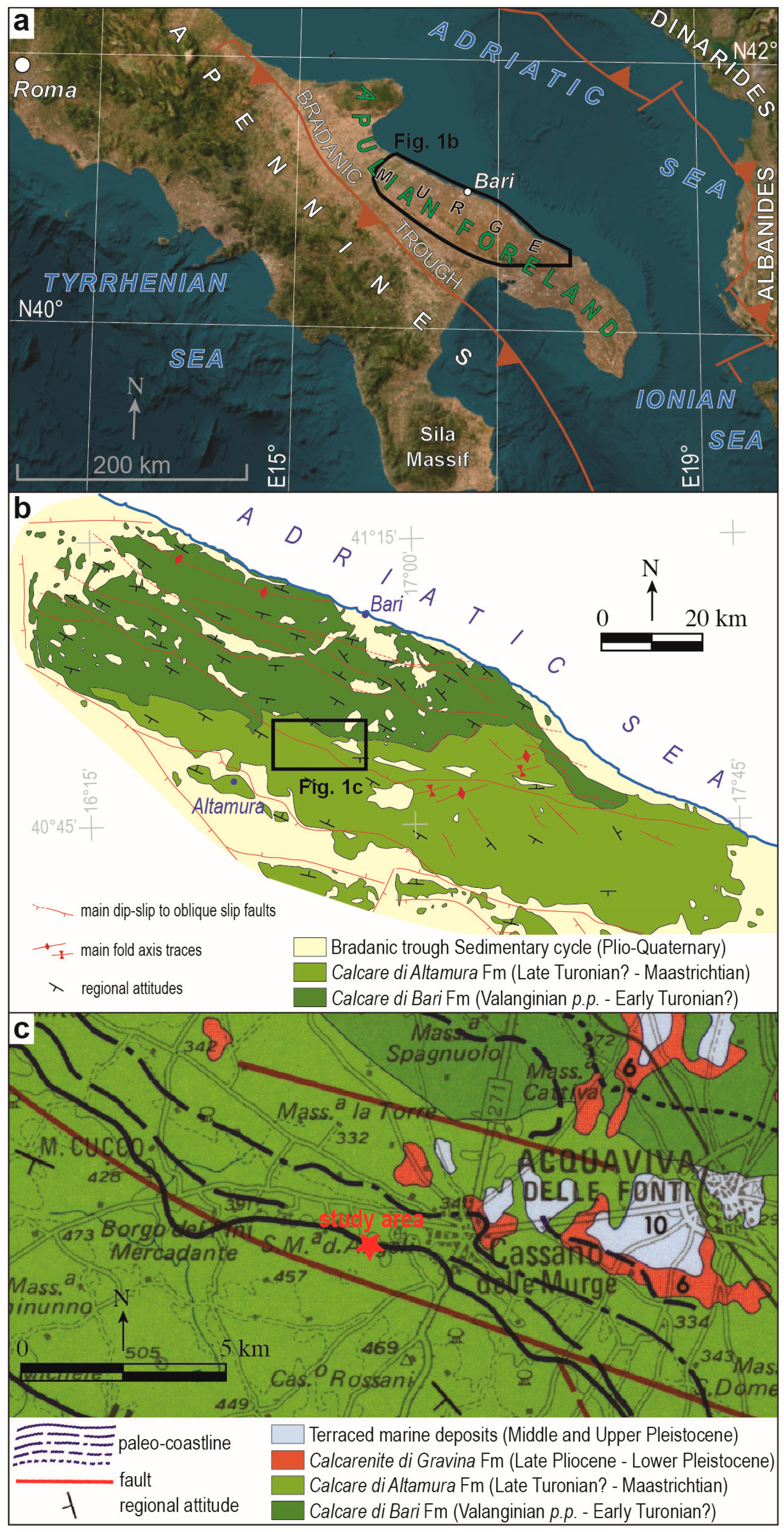
2. Geological Setting
3. Material and Methods
4. Results
4.1. Field Observations and Sampling
4.2. Textural-Petrographic Analysis
4.2.1. Unaltered Limestones
4.2.2. Karst Products
4.3. Geochemistry
5. Discussion
5.1. Terra Rossa and Bauxites in the Apulian Karst
5.2. Genesis of Terra Rossa and Inferences on the Source Material
5.3. Some Remarks on the Cerium Behaviour
6. Conclusions
Author Contributions
Funding
Data Availability Statement
Acknowledgments
Conflicts of Interest
References
- Williams, P.W. The role of the subcutaneous zone in karst hydrology. J. Hydrol. 1983, 61, 45–67. [Google Scholar] [CrossRef]
- Williams, P.W. The role of the epikarst in karst and cave hydrogeology: A review. Int. J. Speleol. 2008, 37, 1–10. [Google Scholar] [CrossRef] [Green Version]
- White, W.B. Karst hydrology: Recent developments and open questions. Eng. Geol. 2002, 65, 85–105. [Google Scholar] [CrossRef]
- Palmer, A.N. Understanding the hydrology of karst. Geol. Croat. 2010, 63, 143–148. [Google Scholar] [CrossRef]
- Stevanovic, Z. Karst Aquifers—Characterization and Engineering; Professional Practice in Earth Science Series; Springer International: Basle, Switzerland, 2015. [Google Scholar]
- Durn, G. Terra rossa in the Mediterranean region: Parent materials, composition and origin. Geol. Croat. 2003, 56, 83–100. [Google Scholar] [CrossRef]
- Muhs, D.R.; Budahn, J.; Avila, A.; Skipp, G.; Freeman, J.; Patterson, D. The role of African dust in the formation of Quaternary soils on Mallorca, Spain and implications for the genesis of Red Mediterranean soils. Quat. Sci. Rev. 2010, 29, 2518–2543. [Google Scholar] [CrossRef]
- White, W.B. Geomorphology and Hydrology of Karst Terrains; Oxford University Press: New York, NY, USA, 1988; p. 480. [Google Scholar]
- Ford, D.C.; Williams, P. Karst Hydrogeology and Geomorphology; John Wiley and Sons Inc.: Chichester, UK, 2007. [Google Scholar]
- Singer, A. The Soils of Israel; Springer: Berlin/Heidelberg, Germany, 2007; p. 306. [Google Scholar] [CrossRef]
- Ciaranfi, N.; Pieri, P.; Ricchetti, G. Note alla Carta Geologica delle Murge e del Salento (Puglia centromeridionale). Mem. Della Soc. Geol. Ital. 1988, 41, 449–460. [Google Scholar]
- Spalluto, L.; Pieri, P.; Ricchetti, G. Le facies carbonatiche di piattaforma interna del Promontorio del Gargano: Implicazioni paleoambientali e correlazioni con la coeva successione delle Murge (Italia meridionale, Puglia). Boll. Soc. Geol. Ital. 2005, 124, 675–690. [Google Scholar]
- Yu, W.; Oggiano, G.; Mongelli, G.; Zhou, J.; Buccione, R.; Xu, L.; Mameli, P.; Du, Y. U-Pb detrital zircon ages and Hf isotope from Sardinia and Adria Cretaceous bauxite (Italy): Constraints on the Alpine Tethys paleogeography and tectonic evolution. Ore Geol. Rev. 2022, 153, 105272. [Google Scholar] [CrossRef]
- Mongelli, G.; Boni, M.; Buccione, R.; Sinisi, R. Geochemistry of the Apulian karst bauxites (southern Italy). Chemical fractionation and parental affinities. Ore Geol. Rev. 2014, 63, 9–21. [Google Scholar] [CrossRef]
- Mongelli, G.; Buccione, R.; Gueguen, E.; Langone, A.; Sinisi, R. Geochemistry of the apulian allochthonous kars bauxite, Southern Italy: Distibution of critical elements and constraints on Late Cretaceous Peri-Tethyan palaeogeography. Ore Geol. Rev. 2016, 77, 246–259. [Google Scholar] [CrossRef]
- Mongelli, G.; Boni, M.; Oggiano, G.; Mameli, P.; Sinisi, R.; Buccione, R.; Mondillo, N. Critical metals distribution in Tethyan karst bauxite: The cretaceous Italian ores. Ore Geol. Rev. 2017, 86, 526–536. [Google Scholar] [CrossRef]
- Buccione, R.; Mongelli, G.; Sinisi, R.; Boni, M. Relationship between geometric parameters and compositional data: A new approach to karst bauxites exploration. J. Geochem. Explor. 2016, 169, 192–201. [Google Scholar] [CrossRef]
- Sinisi, R. Mineralogical and geochemical features of Cretaceous bauxite from San Giovanni Rotondo (Apulia, Southern Italy): A provenance tool. Minerals 2018, 8, 567. [Google Scholar] [CrossRef] [Green Version]
- Morelli, F.; Cullers, R.L.; Laviano, R.; Mongelli, G. Geochemistry and palaeoenvironmental significance of Upper Cretaceous clay-rich beds from the Peri-Adriatic Apulia Carbonate Platform, southern Italy. Period. Di Mineral. 2000, 69, 165–183. [Google Scholar]
- Moresi, M.; Mongelli, G. The relation between the terra rossa and the carbonate-free residue of the underlying limestones and dolostones in Apulia, Italy. Clay Miner. 1988, 23, 439–446. [Google Scholar] [CrossRef]
- Vingiani, S.; Di Iorio, E.; Colombo, C.; Terribile, F. Integrated study of red Mediterranean soils from southern Italy. Catena 2018, 168, 129–140. [Google Scholar] [CrossRef]
- Mastronuzzi, G.; Valletta, S.; Damiani, A.; Fiore, A.; Francescangeli, R.; Giandonato, P.B.; Iurilli, V.; Sabato, L. Geositi Della Puglia. Ricognizione e Verifica Dei Geositi e Delle Emergenze Geologiche Della Regione Puglia; Graphic Concept Lab: Bari, Italy, 2015; p. 394. [Google Scholar]
- Alfonso, G.; Beccarisi, L.; Pieri, V.; Frassanito, A.; Belmonte, G. Using crustaceans to identify different pond types. A case study from the Alta Murgia National Park, Apulia (South-eastern Italy). Hydrobiologia 2016, 782, 53–69. [Google Scholar] [CrossRef]
- Festa, V.; Teofilo, G.; Tropeano, M.; Sabato, L.; Spalluto, L. New insights on diapirism in the Adriatic Sea: The Tremiti salt structure (Apulia offshore, southeastern Italy). Terra Nova 2014, 26, 169–178. [Google Scholar] [CrossRef]
- Tropeano, M.; Pieri, P.; Moretti, M.; Festa, V.; Calcagnile, G.; Del Gaudio, V.; Pierri, P. Quaternary tectonics and seismotectonic features of the Murge area (Apulian foreland, SE Italy)/Tettonica quaternaria ed elementi di sismotettonica nell’area delle Murge (Avampaese Apulo). Alp. Maditerranean Quat. 1997, 10, 543–548. [Google Scholar]
- Festa, V. Cretaceous structural features of the Murge area (Apulian Foreland, Southern Italy). Ecol. Geol. Helv. 2003, 96, 11–22. [Google Scholar] [CrossRef]
- Selli, R. Il Paleogene nel quadro della geologia dell’Italia meridionale. Mem. Soc. Geol. It 1962, 3, 737–790. [Google Scholar]
- Ricchetti, G.; Ciaranfi, N.; Luperto Sinni, E.; Mongelli, F.; Pieri, P. Geodinamica ed evoluzione sedimentaria e tettonica dell’avampaese apulo. Mem. Soc. Geol. It. 1988, 41, 57–82. [Google Scholar]
- Sauro, U. A polygonal karst in the Alte Murge (Puglia, Southern Italy). Z. Geomorph. 1991, 35, 207–223. [Google Scholar] [CrossRef]
- Parise, M. Surface and subsurface karst geomorphology in the Murge (Apulia, southern Italy). Acta Carsologica 2011, 40, 79–93. [Google Scholar] [CrossRef]
- Iannone, A.; Pieri, P. Neotectonic characteristics of the Murge area/Caratteri neotettonici delle Murge. Geol. Appl. E Idrogeol. 1982, 17, 147–159. [Google Scholar]
- Spalluto, L.; Pieri, P.; Sabato, L.; Tropeano, M. Nuovi dati stratigrafici e cartografici delle unità quaternarie del Foglio 438 “BARI” (Puglia-Italia meridionale). Alp. Mediterr. Quat. 2010, 23, 3–14. [Google Scholar]
- Festa, V.; Fiore, A.; Parise, M.; Siniscalchi, A. Sinkhole evolution in the Apulian karst of southern Italy: A case study, with some considerations on sinkhole hazards. J. Cave Karst Stud. 2012, 74, 137–147. [Google Scholar] [CrossRef]
- Pepe, M.; Parise, M. Structural control on development of karst landscape in the Salento Peninsula (Apulia, SE Italy). Acta Carsologica 2014, 43, 101–114. [Google Scholar] [CrossRef]
- Acquafredda, P.; Muntoni, I.M.; Pallara, M. Reassessment of WD-XRF method for obsidian provenance shareable databases. Quat. Int. 2018, 468, 169–178. [Google Scholar] [CrossRef]
- Spalluto, L.; Caffau, M. Stratigraphy of the mid-Cretaceous shallow-water limestones of the Apulia Carbonate Platform (Murge, Apulia, southern Italy). Ital. J. Geosc. 2010, 129, 335–352. [Google Scholar] [CrossRef]
- Spalluto, L. Facies evolution and sequence chronostratigraphy of a mid-Cretaceous shallow-water carbonate succession of the Apulia Carbonate Platform from the Northern Murge area (Apulia, southern Italy). Facies 2012, 58, 17–36. [Google Scholar] [CrossRef]
- Chiocchini, M.; Farinacci, A.; Mancinelli, A.; Molinari, V.; Potetti, M. Biostratigrafia a foraminiferi, dasicladali e calpionelle delle successioni carbonatihce mesozoiche dell’Appennino centrale (Italia). Studi Geol. Camerti. Biostratigrafia Dell’italia Cent. 1995, 1994, 9–12. [Google Scholar]
- Checconi, A.; Rettori, R.; Spalluto, L. Biostratigrafia a foraminiferi del Cretaceo Superiore della successione di Parco Priore (Calcare di Altamura, Piattaforma Apula, Italia Meridionale). Ann. Dell’univ. Di Ferrara Mus. Sci. Nat. 2008, 4, 1–11. [Google Scholar]
- Evensen, N.M.; Hamilton, P.J.; O’nions, R.K. Rare-earth abundances in chondritic meteorites. Geochim. Et Cosmochim. Acta 1978, 42, 1199–1212. [Google Scholar] [CrossRef]
- Mondillo, N.; Balassone, G.; Boni, M.; Rollinson, G. Karst bauxites in the Campania Apennines (southern Italy): A new approach. Period. Di Mineral. 2011, 80, 407–432. [Google Scholar]
- Merino, E.; Banerjee, A. Terra rossa genesis, implications for karst, and eolian dust: A geodynamic thread. J. Geol. 2008, 116, 62–75. [Google Scholar] [CrossRef] [Green Version]
- Dell’Anna, L.; De Marco, A.; Ricchetti, G.; Di Pierro, M. Ricerche geologiche e mineralogiche sulle “Calcareniti di Monte Castiglione”. Boll. Soc. Geol. It 1978, 97, 451–474. [Google Scholar]
- Allocca, V.; Celico, F.; Celico, P.; De Vita, P.; Fabbrocino, S.; Mattia, C.; Monacelli, G.; Musilli, I.; Piscopo, V.; Scalise, A.R.; et al. Carta Idrogeologica Dell’italia Meridionale; Istituto Poligrafico e Zecca Dello Stato: Roma, Italia, 2007. [Google Scholar]
- Gutierrez, F.; Parise, M.; De Waele, J.; Jourde, H. A review on natural and human-induced geohazards and impacts in karst. Earth Sci. Rev. 2014, 138, 61–88. [Google Scholar] [CrossRef]
- Parise, M. Sinkholes. In Encyclopedia of Caves, 3rd ed.; White, W.B., Culver, D.C., Pipan, T., Eds.; Academic Press, Elsevier: Cambridge, MA, USA, 2019; pp. 934–942. ISBN 978-0-12-814124-3. [Google Scholar]
- Parise, M. Sinkholes, Subsidence and Related Mass Movements. In Treatise on Geomorphology; Shroder, J.J.F., Ed.; Academic Press, Elsevier: Cambridge, MA, USA, 2022; Volume 5, pp. 200–220. [Google Scholar]
- Taylor, S.R.; McLennan, S.M. The Continental Crust: Its Composition and Evolution; Blackwell Scientific Publications: Oxford, UK, 1985; p. 312. [Google Scholar]
- Özyurt, M.; Kırmacı, M.Z.; Al-Aasm, I.; Hollis, C.; Taslı, K.; Kandemir, R. REE characteristics of Lower Cretaceous Limestone Succession in Gümüşhane, NE Turkey: Implications for Ocean Paleoredox conditions and diagenetic alteration. Minerals 2020, 10, 683. [Google Scholar] [CrossRef]
- Braun, J.J.; Pagel, M.; Muller, J.P.; Bilong, P.; Michard, A.; Guillet, B. Cerium anomalies in lateritic profiles. Geochim. Et Cosmochim. Acta 1990, 54, 781–795. [Google Scholar] [CrossRef]
- Mongelli, G. Ce-anomalies in the textural components of Upper Cretaceous karst bauxites from the Apulian carbonate platform (southern Italy). Chem. Geol. 1997, 140, 69–79. [Google Scholar] [CrossRef]



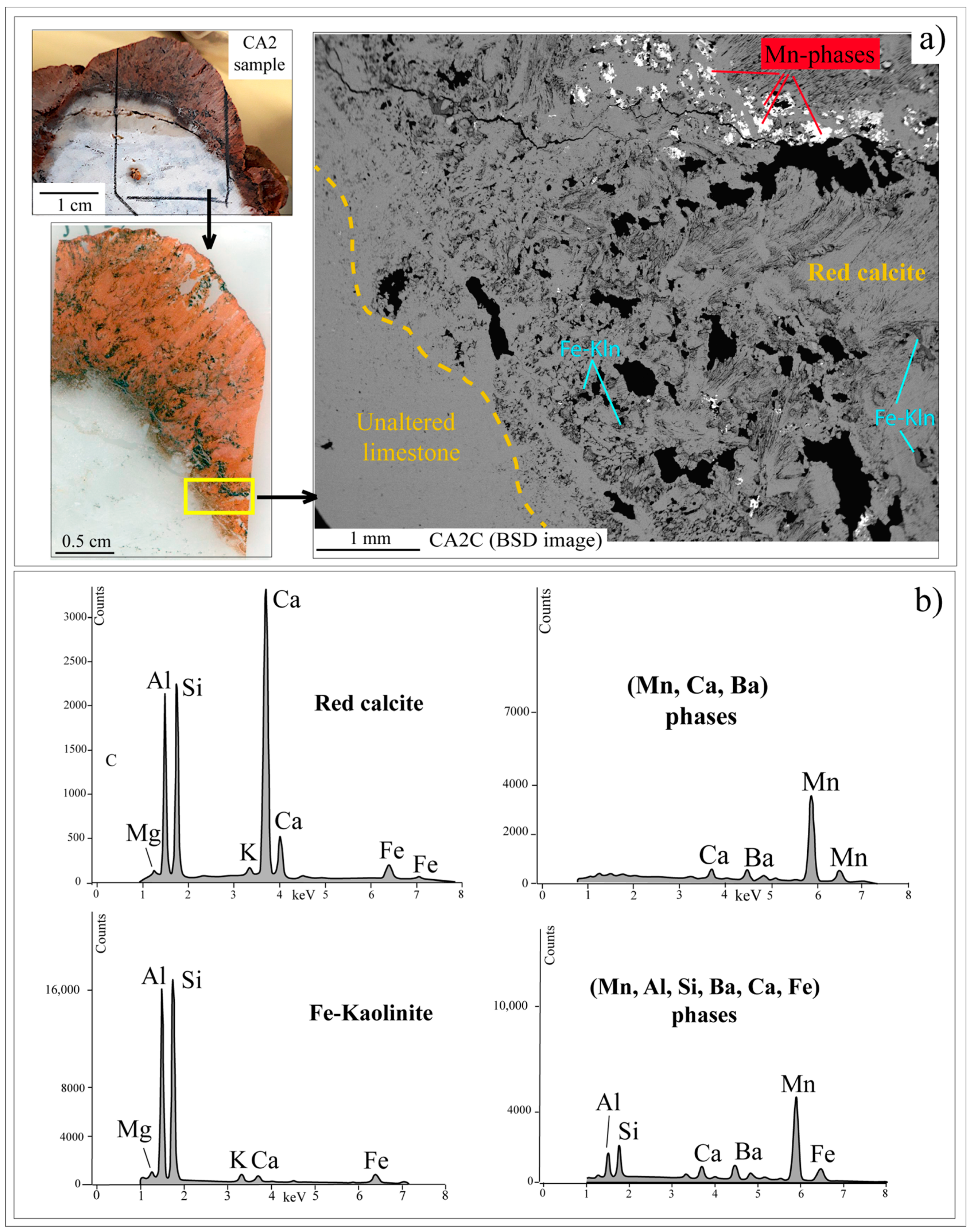
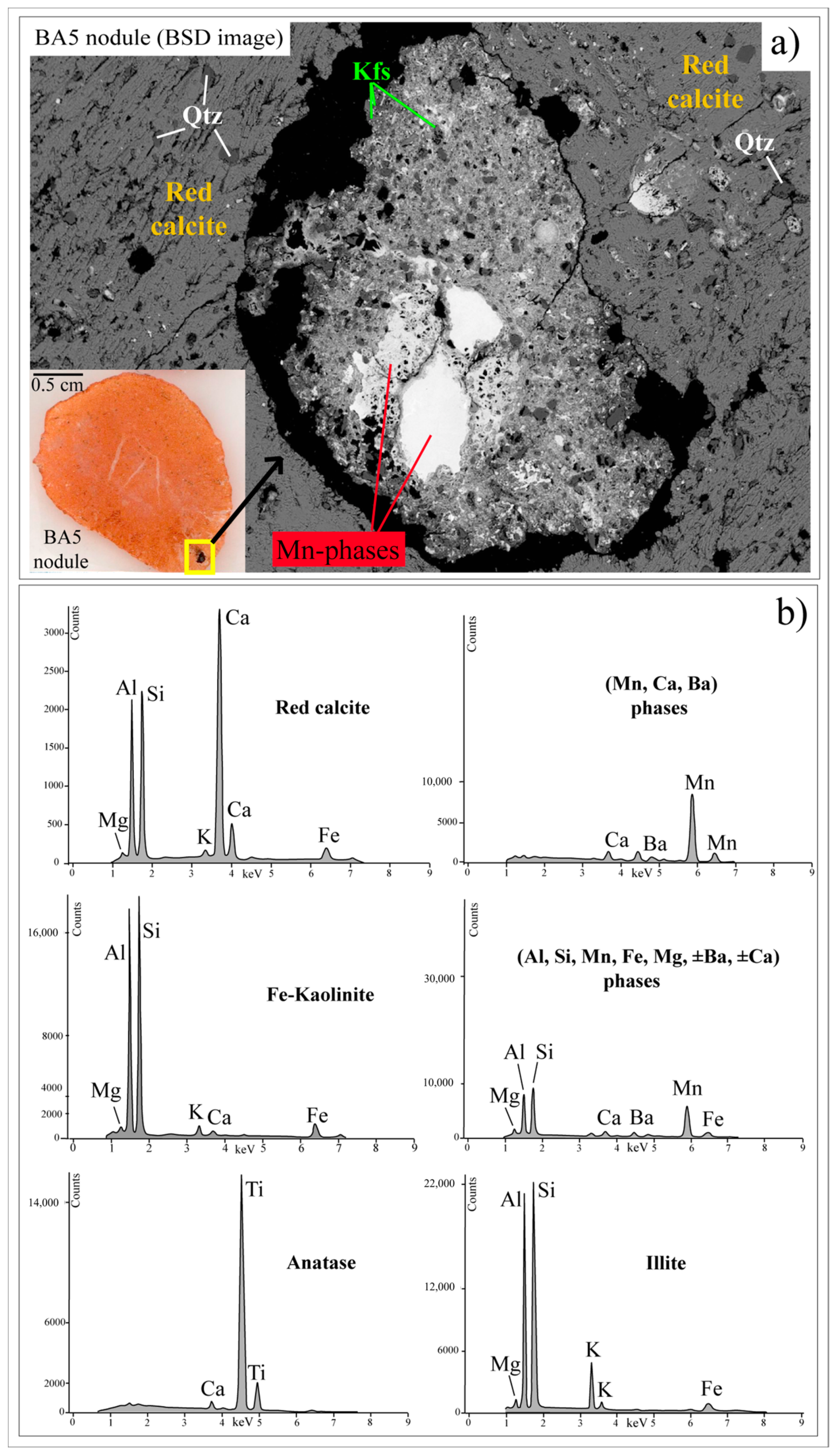


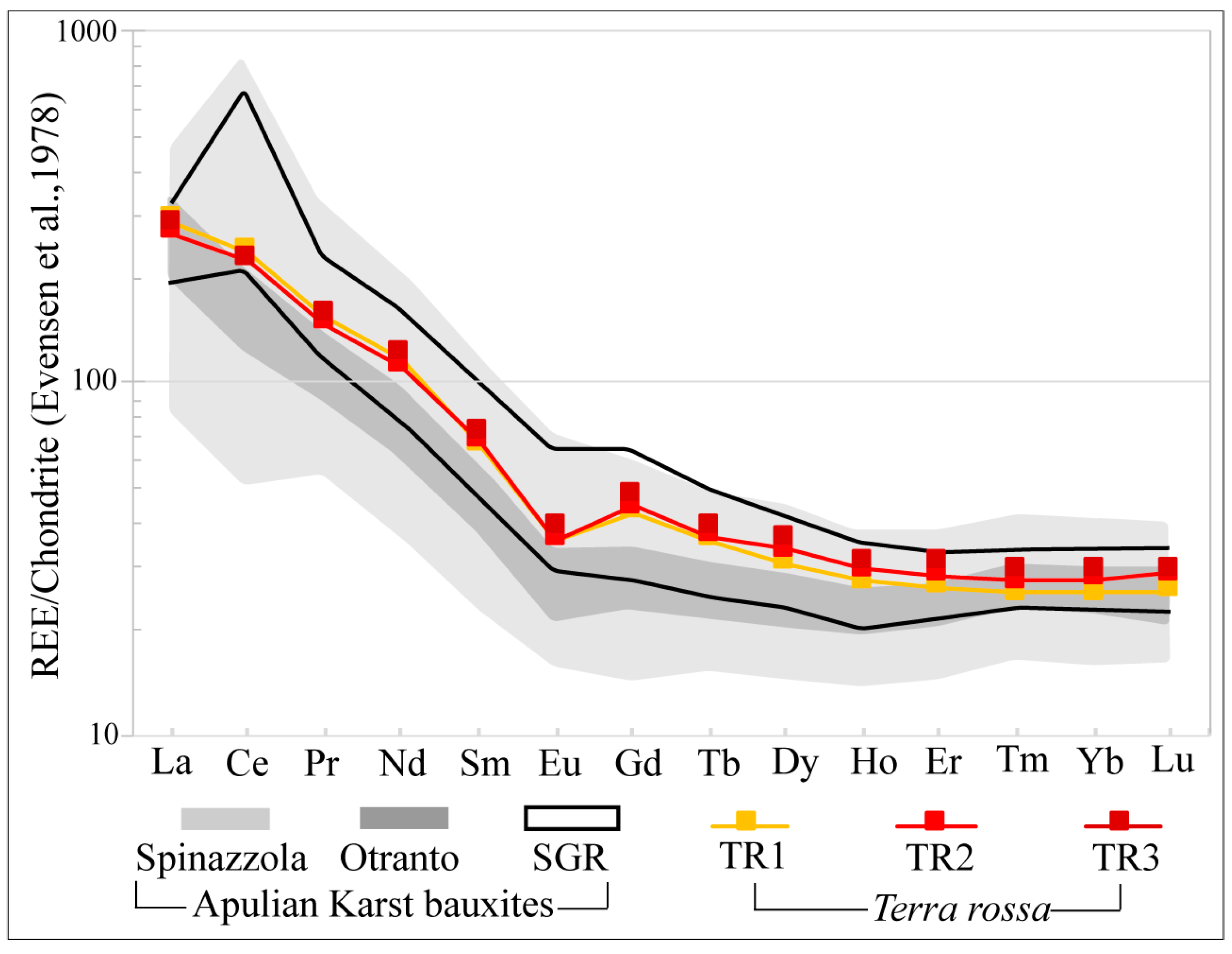
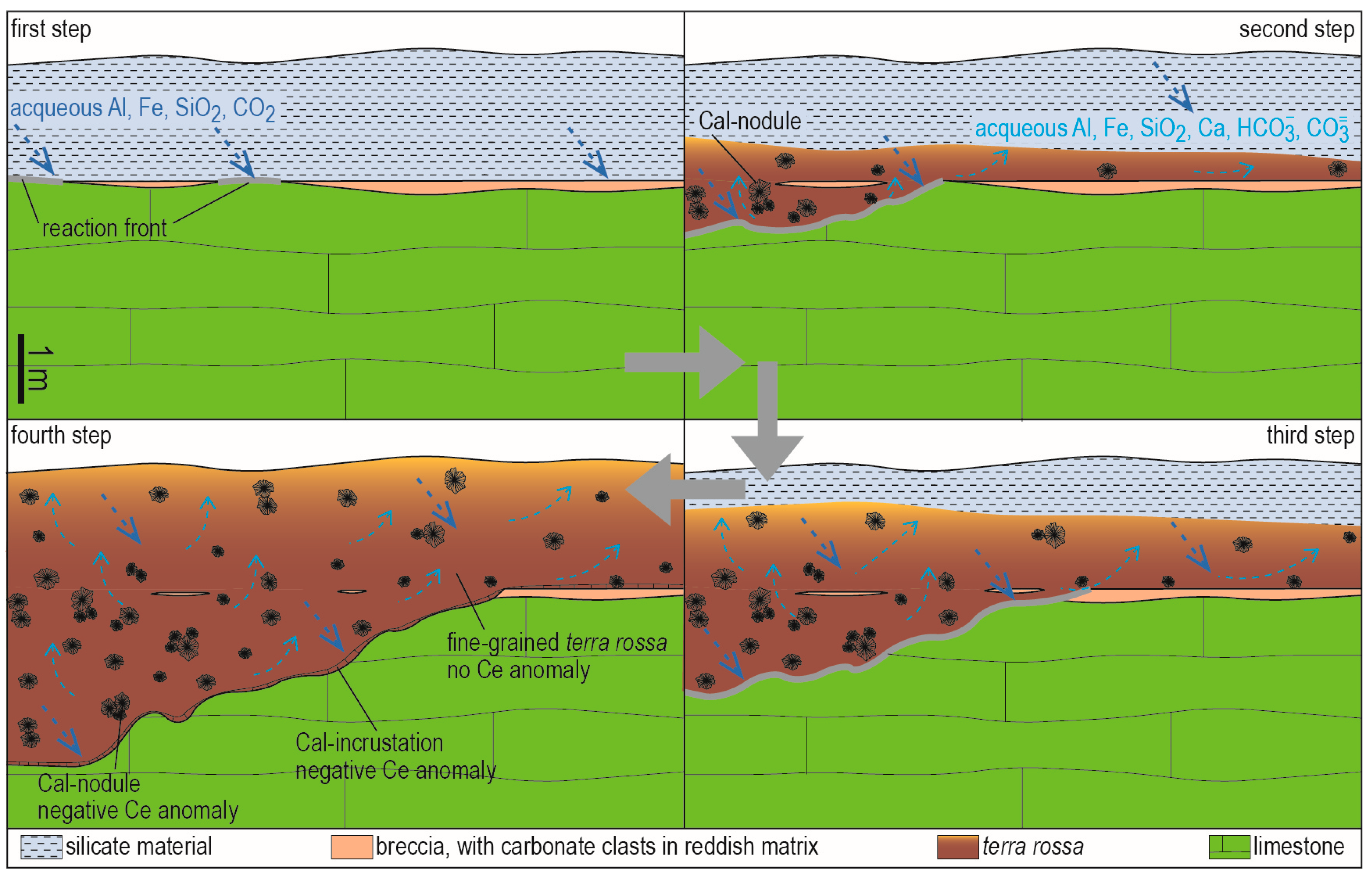
| Sample | SiO2 | TiO2 | Al2O3 | Fe2O3 | MnO | MgO | CaO | Na2O | K2O | P2O5 | LOI | Rb | Sr | Y | Zr | Nb | |
|---|---|---|---|---|---|---|---|---|---|---|---|---|---|---|---|---|---|
| Limestone (bedrock) | CA1 | 0.14 | 0.00 | 0.08 | 0.02 | 0.03 | 0.13 | 56.57 | 0.02 | 0.00 | 0.00 | 43.00 | 6 | 172 | 1 | 7 | 1 |
| Limestone (bedrock) | CA2 | 0.12 | 0.00 | 0.07 | 0.03 | 0.04 | 0.12 | 56.33 | 0.02 | 0.00 | 0.00 | 43.26 | 5 | 125 | 3 | 6 | 1 |
| mean | 0.13 | 0.00 | 0.08 | 0.03 | 0.04 | 0.13 | 56.45 | 0.02 | 0.00 | 0.00 | 43.13 | 6 | 149 | 2 | 7 | 1 | |
| Cal incrustation (0.5 cm) | CA1C | 1.36 | 0.03 | 0.76 | 0.27 | 0.04 | 0.16 | 54.81 | 0.02 | 0.06 | 0.00 | 42.49 | 10 | 163 | 14 | 17 | 2 |
| Cal incrustation (2 cm) | CA2C | 6.52 | 0.15 | 4.46 | 1.79 | 0.90 | 0.19 | 47.64 | 0.03 | 0.24 | 0.00 | 38.09 | 26 | 26 | 66 | 39 | 5 |
| Cal nodule | BA1 | 9.09 | 0.26 | 4.14 | 1.70 | 0.02 | 0.18 | 47.26 | 0.03 | 0.29 | 0.00 | 37.02 | 28 | 22 | 50 | 70 | 7 |
| Cal nodule | BA2 | 9.12 | 0.27 | 4.25 | 1.87 | 0.11 | 0.19 | 47.24 | 0.04 | 0.33 | 0.00 | 36.58 | 30 | 24 | 62 | 87 | 7 |
| Cal nodule | BA3 | 8.19 | 0.25 | 3.88 | 1.85 | 0.03 | 0.18 | 48.27 | 0.03 | 0.29 | 0.00 | 37.02 | 31 | 25 | 62 | 83 | 7 |
| Cal nodule | BA4 | 7.47 | 0.19 | 4.11 | 1.71 | 0.16 | 0.18 | 47.96 | 0.03 | 0.25 | 0.00 | 37.94 | 26 | 24 | 59 | 57 | 5 |
| Cal nodule | BA5 | 8.68 | 0.25 | 4.13 | 1.80 | 0.02 | 0.21 | 47.70 | 0.04 | 0.32 | 0.00 | 36.86 | 32 | 31 | 57 | 81 | 7 |
| Cal nodule | PI1 | 7.52 | 0.23 | 3.78 | 1.70 | 0.04 | 0.17 | 48.52 | 0.03 | 0.26 | 0.00 | 37.74 | 27 | 23 | 68 | 76 | 7 |
| Cal nodule | PI2 | 9.85 | 0.27 | 5.05 | 2.01 | 0.02 | 0.21 | 45.66 | 0.03 | 0.37 | 0.00 | 36.53 | 33 | 23 | 119 | 73 | 7 |
| Cal nodule | PI4 | 9.41 | 0.28 | 4.20 | 1.79 | 0.03 | 0.19 | 46.91 | 0.03 | 0.30 | 0.00 | 36.86 | 30 | 25 | 43 | 84 | 7 |
| mean | 8.67 | 0.25 | 4.19 | 1.80 | 0.05 | 0.19 | 47.44 | 0.03 | 0.30 | 0.00 | 37.07 | 30 | 24 | 65 | 76 | 7 | |
| terra rossa | TR1 | 49.33 | 1.31 | 23.27 | 8.89 | 0.18 | 1.02 | 2.32 | 0.25 | 2.10 | 0.10 | 11.24 | 166 | 96 | 52 | 398 | 42 |
| terra rossa | TR2 | 50.34 | 1.41 | 23.17 | 8.62 | 0.20 | 0.85 | 2.32 | 0.19 | 1.77 | 0.08 | 11.04 | 139 | 79 | 56 | 410 | 39 |
| terra rossa | TR3 | 48.90 | 1.37 | 22.33 | 8.58 | 0.18 | 0.80 | 3.69 | 0.18 | 1.70 | 0.08 | 12.19 | 132 | 80 | 60 | 411 | 38 |
| mean | 49.52 | 1.36 | 22.92 | 8.70 | 0.19 | 0.89 | 2.78 | 0.21 | 1.86 | 0.09 | 11.49 | 146 | 85 | 56 | 406 | 40 |
| Sample | La | Ce | Pr | Nd | Sm | Eu | Gd | Tb | Dy | Ho | Er | Tm | Yb | Lu | ∑LREE | ∑REE | Eu/Eu* | Ce/Ce* | V | Ni | Cr | Cu | Zn | Ga | Cs | Ba | Hf | Ta | Pb | Th | U | |
|---|---|---|---|---|---|---|---|---|---|---|---|---|---|---|---|---|---|---|---|---|---|---|---|---|---|---|---|---|---|---|---|---|
| Cal incrust | CA 2C | 43.7 | 26.1 | 9.72 | 40.8 | 8.56 | 2.01 | 9.59 | 1.38 | 7.94 | 1.59 | 4.23 | 0.513 | 2.85 | 0.419 | 128.88 | 134.67 | 0.67822 | 0.27681 | 57 | 60 | 40 | 20 | 30 | 6 | 1.5 | 857 | 0.9 | 0.27 | 7 | 3 | 0.63 |
| Cal nodule | BA 4 | 46.1 | 40.2 | 10.1 | 41.2 | 8.14 | 1.7 | 8.16 | 1.19 | 6.47 | 1.27 | 3.38 | 0.423 | 2.59 | 0.394 | 145.74 | 150.85 | 0.63765 | 0.40754 | 44 | 30 | 50 | 20 | 30 | 5 | 1.3 | 173 | 1.3 | 0.3 | 7 | 3 | 0.67 |
| Cal nodule | PI 2 | 37.1 | 33.1 | 8.49 | 35.9 | 8.4 | 2.1 | 11.3 | 1.66 | 10.3 | 2.12 | 5.76 | 0.715 | 4.25 | 0.68 | 122.99 | 130.74 | 0.65892 | 0.4106 | 49 | 30 | 50 | 20 | 50 | 6 | 1.6 | 60 | 1.6 | 0.41 | 8 | 3.93 | 0.69 |
| terra rossa | TR 1 | 70.7 | 151 | 14.8 | 54.9 | 10.3 | 2.08 | 8.77 | 1.34 | 7.85 | 1.55 | 4.39 | 0.653 | 4.17 | 0.653 | 301.7 | 309.26 | 0.66909 | 1.0233 | 191 | 60 | 170 | 30 | 100 | 23 | 10.1 | 420 | 8.1 | 2.31 | 35 | 21.4 | 2.82 |
| terra rossa | TR 2 | 65.7 | 143 | 14.3 | 52.7 | 10.6 | 2.09 | 9.09 | 1.38 | 8.51 | 1.67 | 4.71 | 0.703 | 4.59 | 0.737 | 286.3 | 294.42 | 0.65092 | 1.0371 | 202 | 60 | 190 | 30 | 90 | 22 | 7.6 | 330 | 8.8 | 2.15 | 32 | 19.2 | 2.86 |
| terra rossa | TR 3 | 69.4 | 145 | 15.2 | 57.1 | 11.3 | 2.26 | 9.9 | 1.47 | 9.17 | 1.75 | 5.12 | 0.762 | 4.86 | 0.753 | 298 | 306.64 | 0.65323 | 0.99121 | 205 | 70 | 200 | 30 | 90 | 23 | 7.7 | 325 | 9 | 2.31 | 32 | 19.2 | 2.95 |
Disclaimer/Publisher’s Note: The statements, opinions and data contained in all publications are solely those of the individual author(s) and contributor(s) and not of MDPI and/or the editor(s). MDPI and/or the editor(s) disclaim responsibility for any injury to people or property resulting from any ideas, methods, instructions or products referred to in the content. |
© 2023 by the authors. Licensee MDPI, Basel, Switzerland. This article is an open access article distributed under the terms and conditions of the Creative Commons Attribution (CC BY) license (https://creativecommons.org/licenses/by/4.0/).
Share and Cite
Micheletti, F.; Fornelli, A.; Spalluto, L.; Parise, M.; Gallicchio, S.; Tursi, F.; Festa, V. Petrographic and Geochemical Inferences for Genesis of Terra Rossa: A Case Study from the Apulian Karst (Southern Italy). Minerals 2023, 13, 499. https://doi.org/10.3390/min13040499
Micheletti F, Fornelli A, Spalluto L, Parise M, Gallicchio S, Tursi F, Festa V. Petrographic and Geochemical Inferences for Genesis of Terra Rossa: A Case Study from the Apulian Karst (Southern Italy). Minerals. 2023; 13(4):499. https://doi.org/10.3390/min13040499
Chicago/Turabian StyleMicheletti, Francesca, Annamaria Fornelli, Luigi Spalluto, Mario Parise, Salvatore Gallicchio, Fabrizio Tursi, and Vincenzo Festa. 2023. "Petrographic and Geochemical Inferences for Genesis of Terra Rossa: A Case Study from the Apulian Karst (Southern Italy)" Minerals 13, no. 4: 499. https://doi.org/10.3390/min13040499
APA StyleMicheletti, F., Fornelli, A., Spalluto, L., Parise, M., Gallicchio, S., Tursi, F., & Festa, V. (2023). Petrographic and Geochemical Inferences for Genesis of Terra Rossa: A Case Study from the Apulian Karst (Southern Italy). Minerals, 13(4), 499. https://doi.org/10.3390/min13040499






